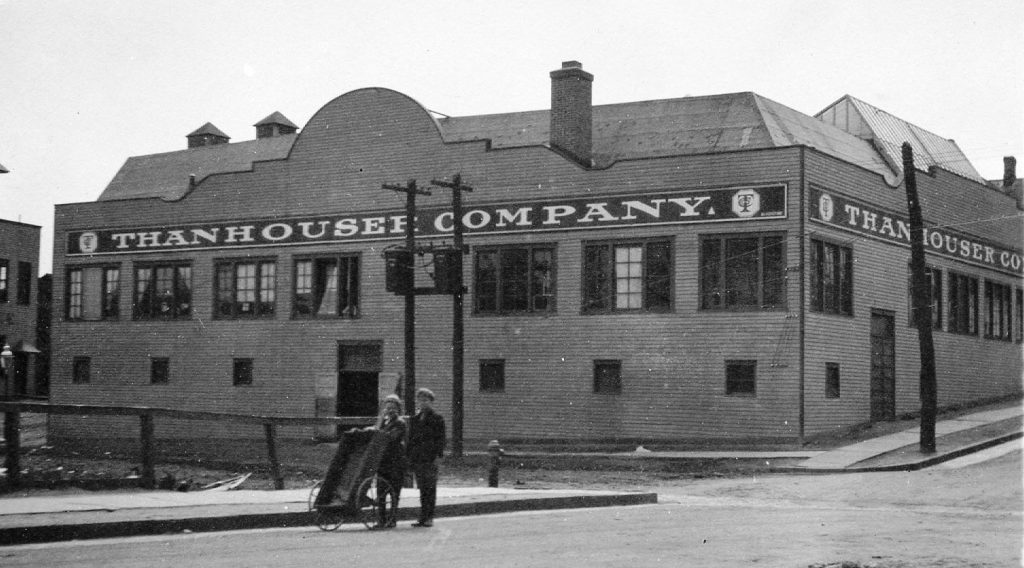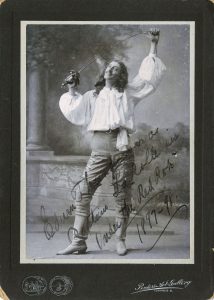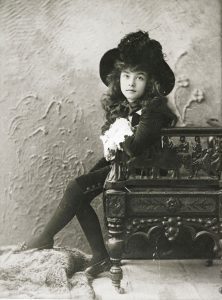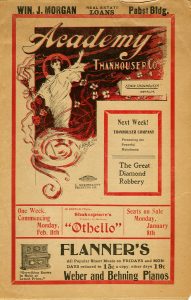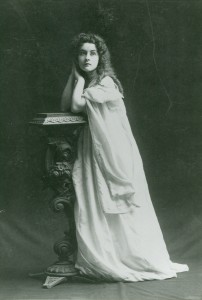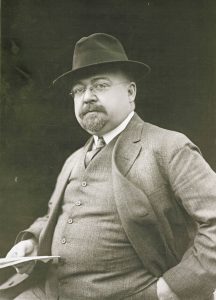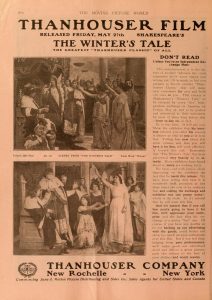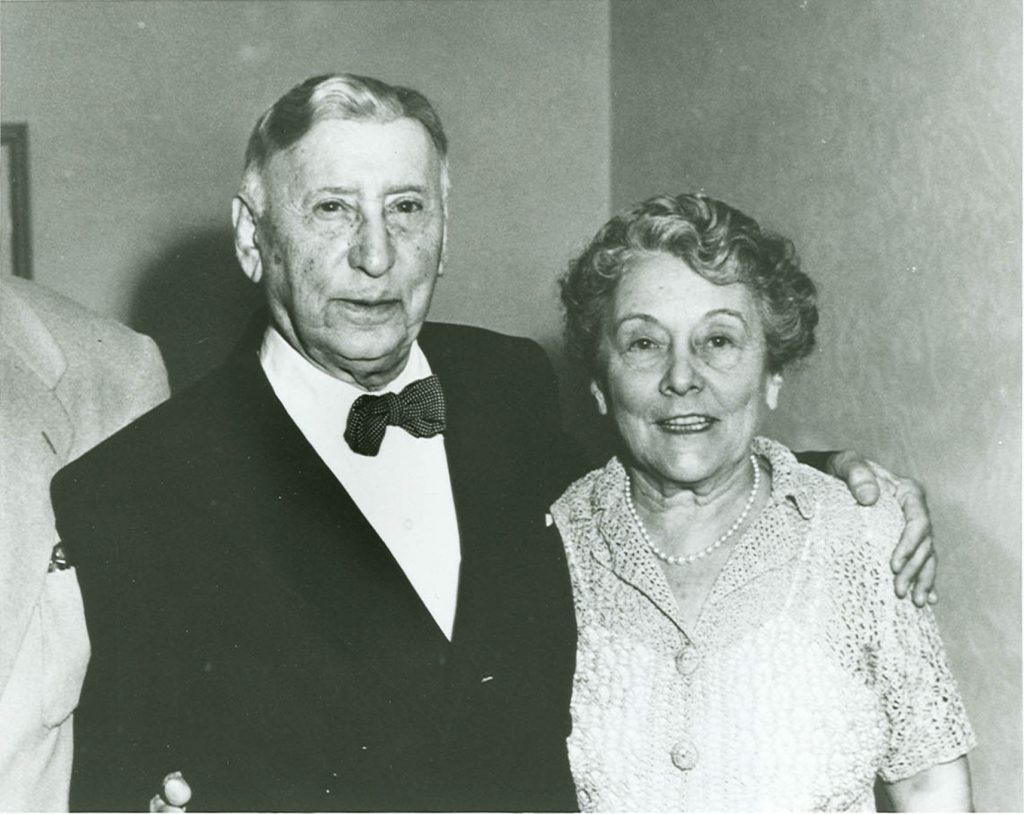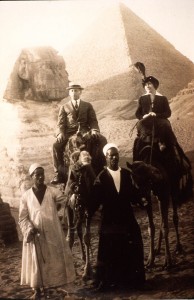Introduction
The family mode of production in the early motion picture industry was firmly established by stage actors and theater management veterans Edwin and Gertrude Thanhouser with brother-in-law and journalist Lloyd F. Lonergan. The three joined forces in 1909 to establish what would become one of America’s pioneering independent silent motion picture studios during what is known as the “transitional” era in early cinema. The talent and the uniqueness of each family member blended seamlessly to create one of the most popular and successful independent motion picture production companies in America’s burgeoning motion picture industry. Under their leadership, the Thanhouser studio strove for and produced high quality films, and by the summer of 1910, Thanhouser films were praised by The New York Dramatic Mirror: “…Thanhouser pictures, of course, rank highest [among the independent producers]” (Woods 1910, 20). The Mutual Film Corporation, a major Chicago-based film distributor, recognized the success of this independent enterprise and, in April 1912, acquired the company under the leadership of Charles J. Hite as one of several to produce films to be distributed to exhibitors under the Mutual banner (McQuade 1912, 212).
Husband and wife Edwin and Gertrude Thanhouser, along with brother-in-law Lonergan, were one of only a handful of studios managed by a close-knit family during the early motion picture industry. A comparison of the evolving production roles at the Thanhouser studio with other contemporary husband-wife teams like Lois Weber and Phillips Smalley at the Rex studio and Alice Guy Blaché and her husband Herbert Blaché at the Solax Company provides a unique insight into the success of the Thanhouser studio.
On the Stage with Edwin Thanhouser
Edwin Thanhouser joined the Salvini theatrical troupe in 1894, playing mostly “one night stands” in numerous cities, towns, and hamlets from coast to coast. When, as reported by The New York Times, Salvini died suddenly of tuberculous in 1896, Edwin joined Charles Frohman’s traveling company and performed in minor roles, such as Captain La Rolle in “Under the Red Robe,” but never in a starring role (1896, 1). Edwin traveled to New York in 1898 where he interviewed for an acting position with the Shubert brothers, but his business acumen impressed the Shuberts more than his acting ability, and he was instead offered a position managing the Academy of Music Theatre in Milwaukee, Wisconsin (L. Thanhouser 1970, 11). Edwin accepted the offer and moved to Milwaukee where he managed a theatrical stock company that typically had a repertoire of comedies, dramas, and adaptations of popular novels of the time. Lighter fare consisted of melodramas, such as “Blue Jeans,” “Lady Audley’s Secret,” “Uncle Tom’s Cabin,” or some other tear-jerking or emotionally inspiring story. If the plays presented were short, with one or two acts, the program of a typical American theatre of the time would have additional features, such as an acrobat, clown, magician, a troupe of dancers or singers, or a monologist who would declaim on politics, the wonders of science, or travel. Beginning in the 1890s, short films were used as fillers between acts. Over time, the program of Thanhouser’s Academy of Music tended toward more sophisticated fare, presenting the works of Shakespeare such as “Othello,” where well-known actors were sometimes secured as guest stars.
Enter: Gertrude Homan
Gertrude Homan was a child star on the New York stage starting in 1888 at age six in “Partners” at the Madison Square Theatre in New York City. The Partners company went to the West Coast in the summer of the same year. An article in The Daily Alta California from August 10, 1888 relates: “‘I am told,’ said the reporter, ‘that you have a remarkable little lady in Gertie Homan; ‘is that so?’ ‘Indeed we have,’ said Mr. Palmer, enthusiastically. ‘She is a wonderful little woman–yes, little woman–for six years of age. We found her very entertaining on our trip, and she was the life of the party. You will see her in Partners’” (8).
During the 1890s Gertrude played roles in “The Burglar” (which was retitled “Editha’s Burglar”), “Bootles’ Baby,” “Romeo and Juliet” (playing Juliet in 1892), “The Childhood of Jack Harkaway,” and many other productions. Her greatest renown was achieved with her roles as Editha and Little Lord Fauntleroy. An undated, unattributed clipping from Gertrude’s scrapbook collection labeled “Partners-Madison Square Theatre” gives a review of Gertrude F. Homan as Little Lord Fauntleroy in the play of the same title: “The fact that the leading role is assumed by so young a character makes the play the more interesting. Miss Gertie Homan played the part of Cedric Errol, Lord Fauntleroy, in a most pleasing manner. She won the admiration of the audience from the start. Her acting is so graceful and her style so charming. Much could be said of this little actress that could hardly be said of many older ones now playing as stars” (n.p.).
Courtship and Marriage
In the days before air conditioning, many theaters–if not most of the larger venues in America, including those on Broadway–were dark during most of June, July, and August due to the oppressive heat indoors. It was therefore customary for headliners to apply for positions out “in the sticks” during the summer months. The reputation of Edwin Thanhouser’s Milwaukee stock company spread as far east as New York, and the Academy of Music was unusual among large Milwaukee theaters in that it remained open during the summer. At these summer playhouses, it was often the practice to employ seasonal troupes consisting of less experienced actors.
One such actor hired by Edwin Thanhouser was sixteen-year-old “Gertie” Homan, who arrived in Milwaukee in early summer of 1898 and was described as “barely five feet tall, crowned with a mass of dark, curly hair surrounding her pansy-like face” (L. Thanhouser 1970, 14). In short: she was quite a charmer. Edwin Thanhouser immediately fell desperately in love. He courted her at every opportunity. After a series of swooning love letters from Edwin and a few crushing rejections from Gertrude, the ever-persistent Edwin eventually won Gertie’s affections and they were married in Brooklyn on February 8, 1900. A front-page article in The New York Times, entitled “Miss Gertie Homan Married,” described the event: “Miss Gertie Homan, who has been known in this city and in the South for some time as an actress in ingénue parts, was married to Edward [sic] Thanhouser last evening at the home of her mother, 291 Prospect Place, Brooklyn” (1900, 1). This union was critical in the formation of the Thanhouser film enterprise as Gertrude’s years on the stage developed her skills in scenario development, production, and stagecraft; she was a perfect complement to Edwin Thanhouser’s business shrewdness and public relations skills.
Exit Milwaukee, Hello Chicago
Edwin Thanhouser’s success managing the Academy of Music Theatre in Milwaukee had, by this time, made him a man of wealth. By 1908, one can imagine that he longed for a greater challenge. Edwin enlisted some of his Thanhouser Stock Company members and departed for seemingly greener pastures in Chicago, a theatre center second only to New York City. There, Edwin leased the Bush Temple Theatre. Although trade reviews in the Chicago Daily Tribune (1908, 8) and The Billboard (1908, 88) were favorable, as was custom, any attendance issues would not have been highlighted, and the Bush Temple Theatre was unfortunately outside the city’s central loop area and suffered often from too many empty seats. By the end of 1908, the nature of the entertainment business in America was changing rapidly as motion pictures gained legitimacy as both entertainment and media. Across the country, many storefronts were being converted into nickelodeons. Being the savvy businessman that he was, and with his box office receipts in decline, Edwin Thanhouser decided to get into the motion picture business.
Enter Lloyd F. Lonergan: Brother-in-Law and Newspaperman
In the spring of 1909, after researching the motion picture industry, Edwin Thanhouser terminated his lease on the Bush Temple Theatre. With their two young children, Lloyd and Marie, they relocated to New York City and moved in with Gertrude’s brother-in-law Lloyd F. Lonergan who was married to Gertrude’s sister, Marie Homan. Lonergan came from a family steeped in storytelling. He was born in Chicago on March 3, 1870 to Thomas Lonergan, a newspaper publisher and editor, and Ellen Lonergan, a newspaper writer born in Ireland. He was educated at the United States Naval Academy, but washed out due to poor eyesight; he followed his family into the newspaper business. He worked for the Hearst organization in Chicago, was on the staff of The New York Evening Journal in 1902, and by 1909 he held a well-paying position at the New York Evening World. In addition, he authored numerous articles and short stories for publication in magazines. His fertile imagination and keen sense of humor enabled him to eventually devise innumerable intriguing and amusing stories for filming at the Thanhouser studio. In those days, he was a short, heavy-set man with a full beard surrounding a smile and a big cigar (L. Thanhouser 1970, 31).
Into the Motion Picture Business
Edwin and Gertrude enticed Lonergan to join them in establishing the Thanhouser Company as an independent motion picture production studio. From the certificate of incorporation dated October 28, 1909, the stated purpose of the company was, “To take, make and exhibit, moving, animated, and stationary pictures and photographs, and to lease rights to exhibit the same…” (1). Edwin Thanhouser needed equipment to produce his films, but was denied a license by the Motion Picture Patents Corporation (MPPC) as part of their monopoly strategy. But, as Terry Ramsaye notes in his 1926 book A Million and One Nights, Thanhouser became a licensee of the Bianchi camera by obtaining a “Columbia License” that allowed him to begin production (498). Both an article in The Photoplay Arts Portfolio and Leon J. Rubenstein at The Billboard noted that Edwin was the first to head an American motion picture studio with a theatrical background (1914, 20; Rubenstein 1911, 14).
According to the certificate of incorporation, the company was capitalized with $10,000 divided into 100 shares; 98 in Gertrude’s name as “secretary,” and one share each to Edwin, as “president,” and Lloyd Lonergan, as “vice-president” (1909, 1). In the 2014 documentary The Thanhouser Studio and the Birth of American Cinema, film historian Shelley Stamp speculated that Gertrude’s 98% share in the company might have been a legal dodge since women were assumed to be less liable in business ventures, or perhaps this was a foreshadowing of her future contributions to the success of the company.
At the Thanhouser Company, the distribution of responsibilities between the three founders was organized around their respective strengths: Edwin was the business leader and external face of the enterprise to the public, Gertrude focused her talents on what she knew best, production design, and the duty of scenario development fell upon the shoulders of newspaperman Lloyd Lonergan.
Edwin Thanhouser: Buisnessman, Visonary, and Spokesman
Edwin’s years of theatrical management in Milwaukee and Chicago thrust him into the role as the manager of the company and chief promoter for the new venture. In a March 1910 interview titled “Thanhouser Company: A New Film Producer,” Edwin articulated why the studio would be successful in the motion picture business: “The Thanhouser Stock Company [in Milwaukee] for years was recognized as one of the foremost in the country. I produced many hundreds of plays, [and] the experience gathered in this way is very helpful, for it has given me…one of the most vital necessities for producing good motion pictures, the knowledge and the value of a dramatic situation and its proper staging” (374).
Later in the same interview, he targeted his audience and the type of films the company would produce:
We do not care to do any pictures that the masses cannot grasp, but that does not mean that our pictures cannot be of a high order. They must appeal to the best instincts of all audiences, and must always tell a moral and logical story. We hope to turn out artistic productions, particularly in the field of legitimate drama and comedy. And when I say comedy, I mean comedy, not slapsticks. From my standpoint, a good moving picture must possess these qualifications: first, it must tell a good, wholesome, logical story without being involved; second, it must be well cast, well-acted, and artistically produced…and, third, it must be as near photographically perfect as possible. These are the kind of pictures we want the Thanhouser films to be–and we will not be satisfied with anything less (374).
Gertrude Thanhouser: The Creative Force Behind the Scenes
Gertrude Thanhouser was not only a talented actress, but from her years on the stage and helping to manage the Academy Theater in Milwaukee and the Bush Temple Theatre in Chicago, she applied her knowledge of stagecraft to the fledgling company. Magazine articles, as well as family history, document Gertrude’s central role in the formation, management, and operation of the company. In the years in New Rochelle during the film business, Gertrude reviewed scripts, wrote scenarios, edited films, and helped Edwin Thanhouser in many ways (Woods 1912, 20).
As I have written in my Women Film Pioneers Project career profile on Gertrude Thanhouser, she was featured in the company’s second release: St. Elmo (1910). The Morning Telegraph‘s review was critical of the acting, complaining that “… the story… is told by the sub-titles in the film, and not so much by the acting” (1910, n.p.). It was the only film on which she received acting credit. Now the mother of two, Gertrude realized that her time before the camera was over, so she applied her theatrical skills behind the scenes to develop future films. Robert Hamilton Ball, in his book Shakespeare on Silent Film, gives credit to Gertrude as a co-scenario writer with Lonergan for the first “Thanhouser Classic” production, The Winter’s Tale (1910), the company’s 14th release on May 27, 1910 (1968, 69). A review of this film published by Moving Picture World on May 28, 1910 was enthusiastic, while not making any mention of Gertrude Thanhouser:
THE THANHOUSER TRIUMP…Dealing with kings and queens, of course, gives an opportunity for magnificence of mounting, costumes and the like of which Mr. Thanhouser is taking full advantage. We come now to the acting, and for this we have none but the highest praise. We have never seen better acting in any moving picture that has come before our eyes. All the parts struck us as properly cast, and throughout the entire production we thought, nay, we are sure, we saw the master hand of an accomplished producer. Every movement, every gesture, every action, was suited to the text of the story. From the point of view of film production Thanhouser’s ‘The Winter’s Tale’ is a masterpiece. And, think of it now, the man who made and produced this picture was absolutely unknown in the moving picture field three months ago (876).
By the summer of 1910, the Thanhouser Company had earned enthusiastic approval as one of the leading independent motion picture production companies. Frank Woods wrote in the New York Dramatic Mirror: “On the other side of the Independent fence, Thanhouser pictures, of course, rank highest. Indeed, the manner in which this new company without previous experience in picture making has developed in quality shows what may be done in film manufacture when intelligence and energy are employed” (1910, 20).
Lloyd Thanhouser, Edwin and Gertude’s son, recalled, in an August 1980 taped audio interview, that Gertrude’s contributions to scenario development, mise-en-scène, and editing helped make these glowing reviews possible:
All the editorial work, the writing of the manuscripts, was handled by the team of my mother and Lloyd Lonergan. She became a very skillful editor of these films. I remember being in the cutting room. She’d count, ‘one, two, three, four…cut!’ And she became extremely adept at matching action when one piece stopped and another started. She was known throughout the industry as one of the most competent technicians in the cutting and editing of motion pictures.
In an interview in the documentary The Thanhouser Studio and the Birth of American Cinema, Stamp also ventured that because of Gertrude’s behind-the-scenes activities and experience in the theatrical realm, she was also most likely intimately involved with wardrobe selection and costuming.
Lloyd F. Lonergan: Master of Scenarios
In the early years from 1910 to 1912, nearly every scenario was credited to Lonergan. During this period, Lonergan, sometimes with the assistance of Gertrude, crafted one scenario a week starting with the company’s first film, The Actor’s Children, released on March 15, 1910. In an interview published on March 6, 1915 in The New Rochelle Pioneer, Lonergan related his work ethic to reporter John W. Kellette: “What are your best hours of work, Mr. Lonergan?” the scribe asked. Lonergan’s answer: “Any old time when the spirit moves me. I have written at every hour of the day.” The reporter continued, “How do you work?” Lonergan responded, “My method is simple. I get an idea, dope it out roughly, smooth off the rough corners, then dictate to a stenographer. I often work on more than one script at a time. I find that while working on drama, it rests me to dash off a comedy in between” (1).
Epes Winthrop Sargent, an American film critic, also wrote in Moving Picture World on April 4, 1914 of Lonergan’s production duties, with no mention of any collaboration with Gertrude:
Almost since the formation of the Thanhouser Company, Lloyd Lonergan has written practically all of the Thanhouser releases; not by merely putting his name on the script he revises, but digging out the idea, getting it on paper and generally cutting the film afterward. We are inclined to think that he has written more produced plays than any single photoplay writer, and his batting average runs about .980. He has kept on year after year, turning out two or three a week and yet never letting the suggestion creep into his stuff that it is machine made (44).
Selling the Studio to Mutual
Just two years after opening, the Thanhouser studio had released 228 films to wide industry praise, many of which went into worldwide distribution according to extensive research that I compiled as “Thanhouser Filmography Analysis” (n.p.). The business of filmmaking had grown from a novelty shown between acts at a vaudeville show to a full-fledged industry in its own right. In April 1912, a group of well-heeled investors led by Charles J. Hite approached the Thanhousers, and they sold their shares in the enterprise to the Mutual Film Corporation for $250,000–twenty-five times their original investment, about $6.5 million in today’s dollars–and the business was renamed the Thanhouser Film Corporation. Initially, Edwin remained as general manager, facilitating the transition in ownership. He was quoted frequently in the trade press and remained the spokesman for the firm bearing his name, but, by autumn of 1912, Edwin and Gertrude decided to leave filmmaking behind and enjoy an extended grand tour of Europe. Lloyd Lonergan remained at the studio in charge of production and scenario development.
Edwin and Gertrude Return
After a two-year hiatus, and unforeseen tragic circumstances that included the untimely death of Charles Hite and the outbreak of World War I, Edwin Thanhouser was approached in February 1915 by Mutual’s board to resume leadership of the Thanhouser studio. Under a three-year contract he resumed his role as president and spokesperson for the studio, Gertrude returned to her desk as head of scenario development, and Lonergan maintained his role as chief of production (Blaisdell 1915, 1451). As I wrote in my career profile on Gertrude, upon returning to the Thanhouser Film Corporation in February 1915, she immediately resumed her role as supervisor of the scenario department and was credited for writing the scenario for their first “new” release, Their One Love (1915). This extant one-reel drama capitalized on the fiftieth anniversary of the end of the Civil War and was a shrewd, competitive response to Griffith’s The Birth of a Nation (1915). Her scenario received positive reviews, such as from Wid Gunning in the Evening Mail, who wrote, “As a whole: A gem; Story: Different…” (1915, 5). Gertrude was also credited as scenario writer for four other films in 1915, including a two-reel comedy-drama, a one-reel drama, and two four-reel “Mutual Masterpicture” feature films. She remained active in company affairs; Moving Picture World noted on February 12, 1916 that she attended a meeting with President Woodrow Wilson (930).
However, contemporary records show that by the fall of 1917 the Thanhouser studio, having produced over one thousand films in just under eight years, was now a minor participant in the burgeoning film industry, as were many other independent early producers like Biograph, Lubin, Kalem, and Edison (Robinson 1968, 112-119). The motion picture industry had moved west to Hollywood and Edwin, once known as “The Wizard of New Rochelle,” did not want to move to California. In fact, he had his sights set firmly on retirement when his three-year contract with Mutual expired. In March 1918, Edwin and Gertrude retired, recommending to the Mutual board to liquidate the studio’s assets. They moved to their new home built on Long Island, permanently leaving the industry; Gertrude died in 1951 and Edwin in 1958.
Lonergan was hired in March 1918 by Theodore C. Deitrich, president of De Lux Pictures, to manage the leased Plimpton Studio in Yonkers where Doris Kenyon was producing her film The Street of Seven Stars (1919), according to a March 1918 article in Moving Picture World (1666). As time went on, suffering from osteoarthritis, his bones shrank, turned brittle, and were easily broken. He suffered several bad fractures, became lame, and eventually housebound; he died in the early 1920s.
In Context: Thanhouser Family Mode of Production
Two other family-led motion picture organizations in early film are worthy of examination to contrast with the Thanhouser studio. First, husband and wife team of Lois Weber and Phillips Smalley were running the Rex brand for Universal starting in 1911. In Shelley Stamp’s analysis for the Women Film Pioneers Project, Weber was the dominant member of this partnership with Smalley often deferring to his wife to make important decisions. Starting in 1917 when they broke away from Universal, Weber’s role was not only as script author, director, and producer, but she was the public face and primary business manager of her company, Lois Weber Productions. Weber believed that cinema went beyond highbrow entertainment to tackling controversial social causes to achieve political change, for example drug abuse in Hop, the Devil’s Brew (1916), poverty and wage equity in Shoes (1916), and contraception in Where Are My Children? (1916) (Stamp 2013). While the Thanhouser studio produced several social issue-oriented films, for example child labor abuse in The Cry of the Children (1912) and the battle-of-the-sexes comedy Petticoat Camp (1913), the Thanhousers were more interested in a financial return than political transformation.
After leading a failed effort for the Gaumont studio to join the Motion Picture Patents Corporation, Alice Guy Blaché, and her husband Herbert Blaché, established the Solax Company in 1910 in Flushing, New York. She was the artistic director and directed many of its films, while her husband managed production for the new company. Solax earned the couple enough income to build a studio in Fort Lee, New Jersey in 1912 that produced melodramas such as A Man’s Man (1912) and comedies like A Comedy of Errors (1912). According to my “Thanhouser Filmography Analysis,” the Thanhouser studio was producing a similar lineup of films with 47% of its titles classified as melodramas and 30% comedies (n.p.). By 1914, however, distribution issues, the shift of the industry from the one-reel format to feature films, and the shift of the industry to the West Coast eventually led to Herbert and Alice Guy hiring out to direct feature films for other studios. The Thanhouser studio was also experiencing the same industry pressures that eventually resulted in its demise in 1917. The roles of the husband and wife founders of Solax in the 1912 to 1914 period align closely with the roles of Edwin and Gertrude at the Thanhouser studio. But the Thanhouser’s retired from the industry in 1918 and remained a couple while Alice Guy and Herbert Blaché divorced in 1920. He continued to work in the motion picture industry into the 1920s while Alice Guy wrote novelizations of film scripts and lectured extensively, but she never made another film (McMahan 2013).
Ahead of Its Time
Family lore, scrapbooks, magazine articles, and written and oral records attest to the unique relationship of the Thanhouser studio founders as independent motion picture producers. They successfully matched each member’s talents to a defined role, giving the Thanhouser studio the ability to produce high quality films that were critically reviewed by the press and admired by the filmgoing public. Edwin and Gertrude’s background in the theatre, both in management and presentation of the films, plus Lonergan’s craft of storytelling and production management distinguished Thanhouser from the competition. The Thanhouser production organizational structure was a forerunner of modern motion picture systems and, in many ways, presaged the modern studio system with its standardized, delineated roles, and a steady eye on the bottom line. In this way, as in others, the Thanhouser studio demonstrated that it was ahead of its time in bringing compelling stories, both classic and studio developed, to the screen with outstanding production design and high quality output. The films that survive today attest to these successes that were enabled by each family member’s background and their forward-looking production model.
Surviving Thanhouser Films Available on DVD and Online
Starting in 1997, I started releasing surviving Thanhouser films for scholarly access and cinephile viewing, complete with new original music composed exclusively for each film along with notes on each film in the collection. As of the writing of this essay, seventy extant Thanhouser films have been released on fifteen DVDs with most available for online viewing at no charge on the Thanhouser Company Film Preservation Inc. website. Additional Thanhouser films are being discovered each year and another release of newly preserved extant Thanhouser titles is scheduled to be released in 2017.
With Q. David Bowers
See also: Gertrude Thanhouser

